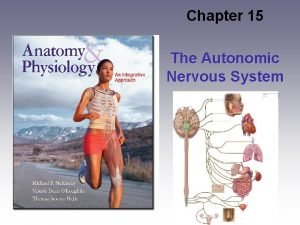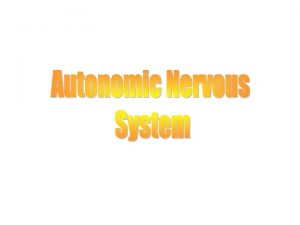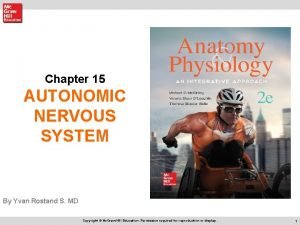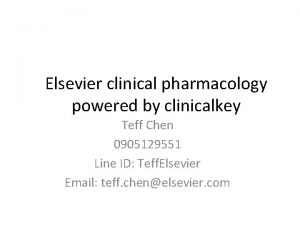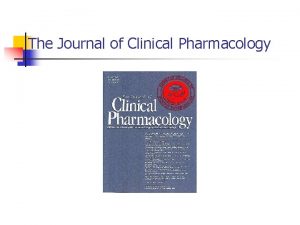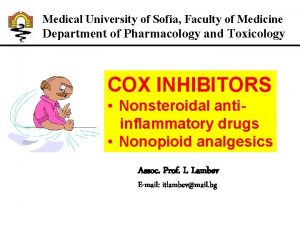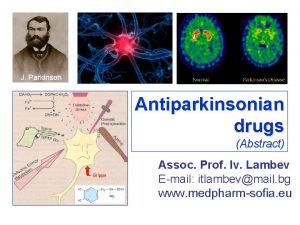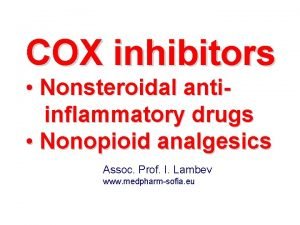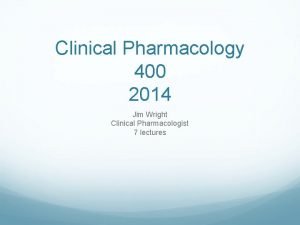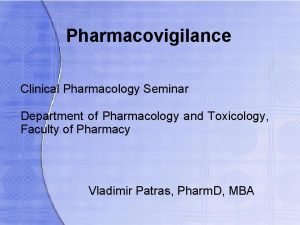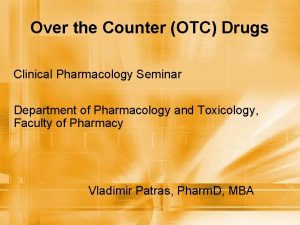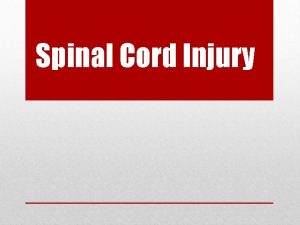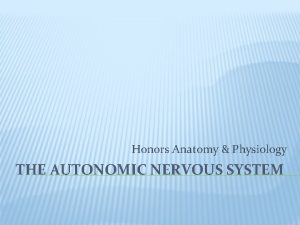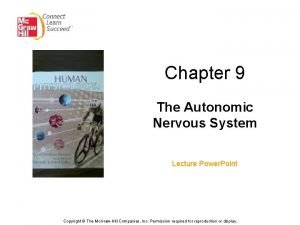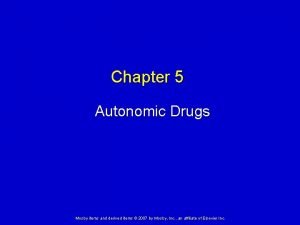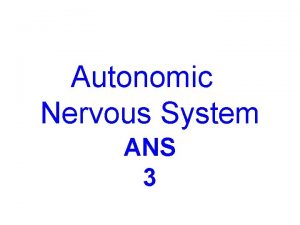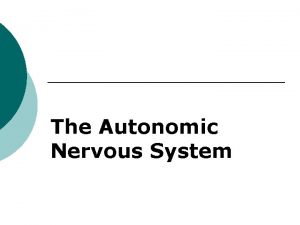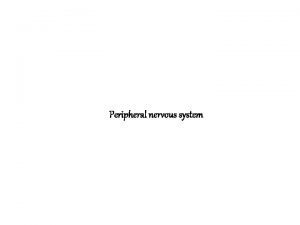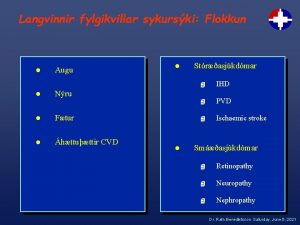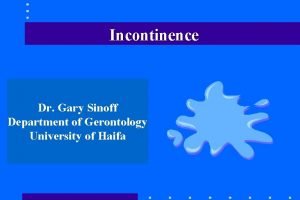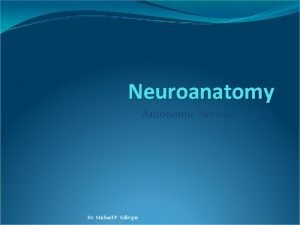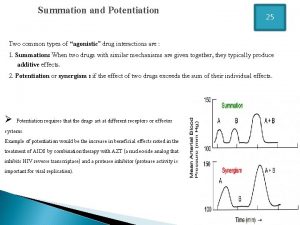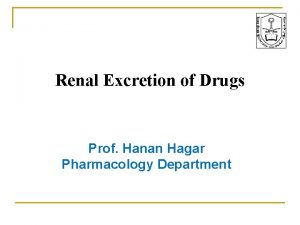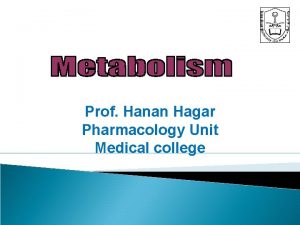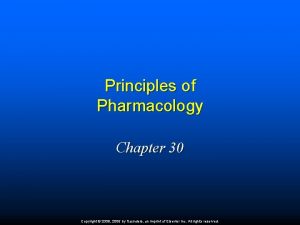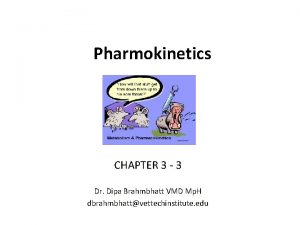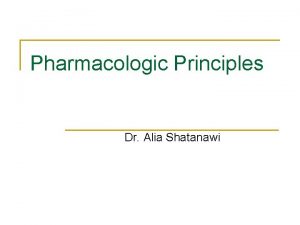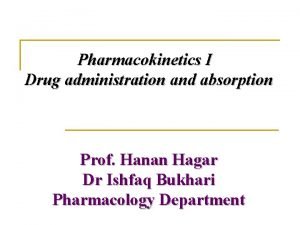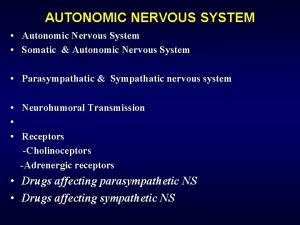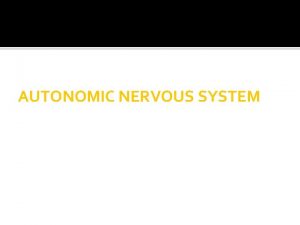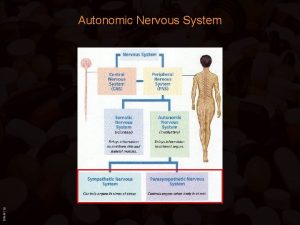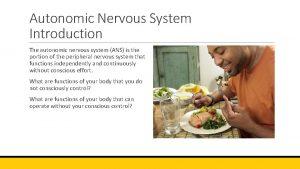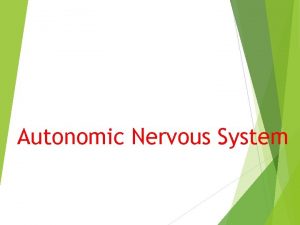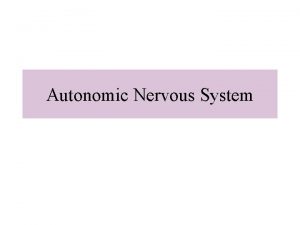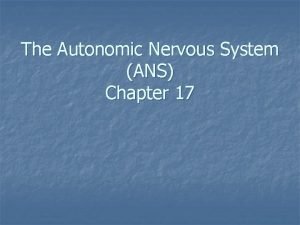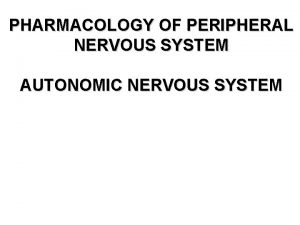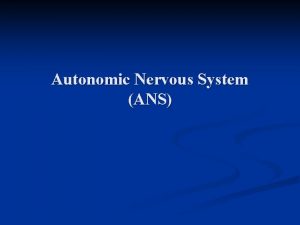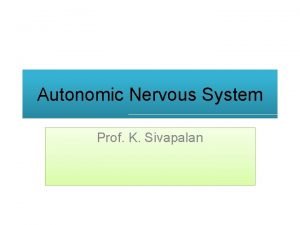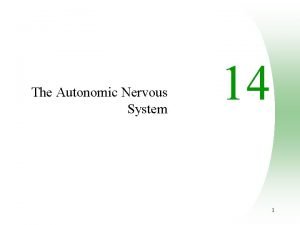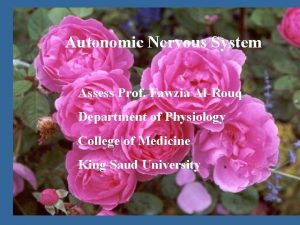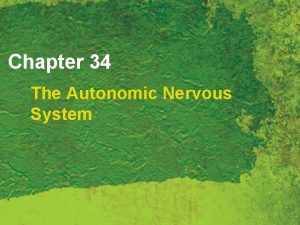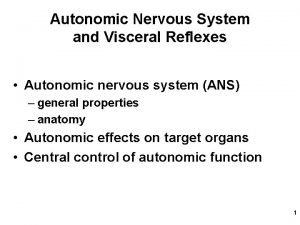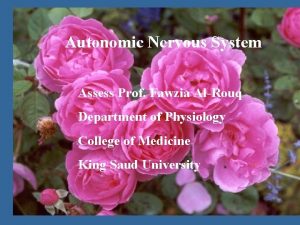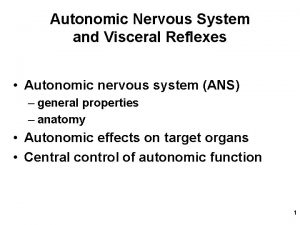Clinical pharmacology ANS Part I Autonomic Nervous System




















































- Slides: 52

Clinical pharmacology ANS Part I

Autonomic Nervous System (ANS) The nervous system is divided into the central nervous system (CNS) and peripheral nervous system. The peripheral nervous system is divided into somatic (voluntary) and the autonomic system –ANS- ” (involuntary). ANS has two divisions: Sympathetic NS and Parasympathetic NS. The enteric nervous system (ENS) is a semiautonomous part of the ANS located in the gastrointestinal tract.

” The motor (efferent) portion of the ANS is the major pathway for information transmission from CNS to the involuntary effector tissues (smooth m, cardiac m, and exocrine gland).

Important terms in therapeutics: Placebo: an inert substance that creates either a positive response or no response in a subject who takes it. Sometimes patients given a placebo treatment will have an actual improvement in a medical condition. Nocebo: is a harmless substance that creates harmful effects in a patient who takes it. Generally, there is no voluntary control of the ANS, although conscious modulation can occur transiently.


Q// It is very important to understand drugs that effect autonomic nervous system? Why.

Autonomic drugs are used for the treatment of Angina

Autonomic drugs are used for the treatment of Heart Failure

Autonomic drugs are used for the treatment of Alzheimer’s Disease

Autonomic drugs are used for the treatment of High Blood Pressure

Autonomic drugs are used for the treatment of Benign Prostatic Hypertrophy

Autonomic drugs are used for the treatment of Anaphylactic Shock

Autonomic drugs are used for the treatment of Septic Shock

Autonomic drugs are used for the treatment of Asthma

Autonomic drugs are used for the treatment of vagal over activity Vasovagal syncope is a sudden brief loss of consciousness (syncope) due to activation of the vagus nerve. This activation may occur due to triggers, such as the sight of blood or emotional distress. Early signs or symptoms such as lightheadedness, nausea, the feeling of hot or cold (accompanied by sweating), ringing in the ears, confusion, a slight inability to speak , weakness and visual disturbances, When people lose consciousness, they fall down and, when in this position, effective blood flow to the brain is immediately restored, allowing the person to regain consciousness. If the person does not fall into a fully flat, supine position, and the head remains elevated above the trunk, a state similar to a seizure

Pathophysiology 1) Cardio inhibitory response, characterized by a drop in heart rate (negative chronotropic effect) and in contractility (negative inotropic effect) leading to a decrease in cardiac output that is significant enough to result in a loss of consciousness. It is thought that this response results primarily from enhancement in parasympathetic tone. 2) Vasodepressor response, caused by a drop in blood pressure due to dilation of the blood vessels , probably as a result of withdrawal of sympathetic nervous system tone. Medications which may be effective include: CNS stimulants fludrocortisone , paroxetine , atropine , epinephrine

Typical parasympathetic responses include: Slowing the heart rate Lowering blood pressure Emptying the bladder Noisy breathing (bronchial constriction) Increased salivation Increased gut motility. Protecting the retina from light (miosis).

Typical sympathetic responses include: Increase in heart rate Shift in blood flow to muscles Increase in blood glucose levels Blood vessels constrict. Bronchioles dilate. Hair becomes erected on skin. Dilation of the pupils (mydriasis)

Generally, it can be said that: Parasympathetics are involved with anabolic processes, rest and digest response Occur in discrete maneuver Sympathetic are involved with catabolic processes, flight and fright Occur in continuous maneuver A more modern characterization is that the sympathetic nervous system is a "quick response mobilizing system" and the parasympathetic is a "more slowly activated dampening system

FUNCTIONS OF PSNS Dominate roles • under normal physiological condition Digest and • Rest

FUNCTIONS OF SNS prepares organism • to handle various environmental stresses Fight and • Flight

Physiological antagonists The sympathetic and parasympathetic systems usually do not function independently; i. e. , they are physiological antagonists

A-Cholinergic Transmission


2 -Rlease of Ach release requires the entry of ca through cachannals and triggering of interaction results in opening of a pore to the extracellular space, and the released of stored Ach (release of Ach is inhibited by botulinum toxins). Botulinum toxins is neurotoxins which produced and liberated by Clostridium botulinum. 3 -Termination of action of Ach Action terminated by metabolism to acetate and choline by the action of acetylcholinesterase {Ach estrase} in the synaptic cleft. Inhibition of Ach estrase are an important theraputic (and toxic)effects of several drugs

Botulinum toxin is a protein and neurotoxin produced by the bacterium Clostridium botulinum. Three forms of botulinum toxin type A (Botox, Dysport and Xeomin) and one form of botulinum toxin type B (Myo. Bloc) are available commercially for various cosmetic and medical procedures. Botulinum toxin has been recognized and feared as a potential bioterror weapon. .

Therapeutic uses 1)Blepharospasm and strabismus Blepharospasm Excessive blinking and spasming of the eyes, usually characterized by uncontrollable eyelid closure of durations longer than the typical blink reflex, sometimes lasting minutes or even hours The beneficial effects of the injection lasted only 4– 6 months. Thus, blepharospasm patients required re-injection two or three times a year. .

2)Upper motor neuron syndrome such as cerebral palsy, for muscles with an impaired ability to effectively lengthen. 3)Sweating BTX-A was later approved for the treatment of excessive underarm sweating. This is technically known as severe primary axillary hyperhidrosis – excessive underarm sweating with an unknown cause . . .

Hyperhydrosis

4)Chronic migraine FDA approval for treatment of chronic migraines on October 2010. The toxin is injected into the head and neck to treat these chronic headaches. .

5) Obesity. Injection of Botox through endoscope in special area leads to muscles relaxation and reduced gastric empty rate and t reduce the ghrelin hormone leading to decrease sensation of hunger. Procedure take 5 min with short anesthetics (midozolam) .

6) Cosmetic uses In cosmetic applications, a Botox injection, consisting of a small dose of botulinum toxin, can be used to prevent development of wrinkles by paralyzing facial muscles. Following treatment, visible results of Botox Cosmetic are usually seen within 3– 5 days, however it can take up to 2 weeks to see full results.


Cosmetic Uses of BTX Basic applications Horizontal forehead lines Glabellar frown lines Lateral and medial brow lifts Crow’s feet Advanced and other applications Nasal scrunch and flare Upper lip wrinkles Marionette (sad) lines Neck lines and Facial asymmetry Hyperhidrosis


7) Dental uses: A-Bruxism {20 units in each masseter and 10 units in each temporallis muscle} -.

B) Temporomandibular Disorders The most commonly affected muscles are the temporalis muscle, masseter muscle and lateral pterigoid muscles. We performe injections under the guidance of electromyography (EMG) using a 27 -gauge monopolar electrode injection needle. The temporalis and masseter muscles are injected transcutaneously. lateral pterygoid muscle is done intraorally with the EMG needle placed. We starting with a dose of 10– 25 units for temporalis muscle, 25– 50 units to the masseter muscles and 7. 5– 10 units to the lateral pterygoids. Subsequent doses are individualized and are based on

C) Sialorrhea We performed topical anesthesia with prilocaine in the parotid gland (PG) and submandibular gland (SG) region thirty minutes before the application. The application of Botox® in the PG region was made in two points: 10 U in the angle between the posterior mandible angle and mastoid process and 10 U in the angle between the zigomatic process and the ascending mandible process. In SG, we used ultrasound-guided application and injected 30 U in each gland in a central point. .

D) Gummy smile n n n For the patient whose gummy smile was mainly caused due to hyperactive lip muscles, treatment with Botox was considered as an alternative treatment approach. When injected intramuscularly at therapeutic doses, it produces partial chemical denervation of the muscle, resulting in localized reduction in muscle activity. After injecting 2. 5 U Botulinum toxin on both the side, reduction in excessive gingival display was noticed with maximum effect

B-Adrenergic Transmission Norepinephrine(NE) is the primary transmitter except sympathetic fibers to sweat gland probably sympathetic vasodilator fibers to skeletal m. (which release Ach) Dopamine is a vasodilator in renal Blood vessles , but NE is a vasoconstrictor of these vessles



Receptors Characteristics: A-Cholinoceptors 1 -Nicotinic Receptors -Respond to Ach {Agonist}. -Respond to nicotine (another ACh mimic) -Act through Ligand-gated ion channels -Agonist effects blocked by tubocurarine {antagonist}. 2 Subtypes of nicotinic receptors: a) Nn-neuronal : Are at ganglia (effects blocked with ganglionic blockers (e. g. , trimethaphan, hexamethonium) b) Nm-neuromuscular (skeletal muscle): are at the neuromuscular junction (effects blocked with neuromuscular blockers (e. g. , curare)

2 -Muscarinic Receptors -Respond to muscarine (agonist) -Respond to Ach (agonist) -G-protein coupled receptor system -Slower responses -Agonist effects blocked by atropine (antagonist) At least there are five types of muscarinic receptor :

B-Adrenoceptors: 1 -Alpha receptors 2 subtypes a) alpha –adrenergic receptors: Alpha (α)1 -effector tissues{ smooth muscles, glands} Alpha (α)2 -nerve endings, some smooth muscles. b) Beta- receptors -Beta 1 Located on most types of smooth muscle , cardiac muscle , and some presynaptic nerve terminal. -Beta 2 located in smooth muscles of {GIT , uters } , liver , heart , and lung (bronchi) - Beta-3 Located on lipocytes of brown fat {by stimulation leads to lipolysis → W T loss

C-Dopamine receptors are subclass of adrenoceptors but they are different in distribution and function. They are especially important in renal and splanchnic vessels as well as brain Five subtypes, D 1 is the most important dopamine receptor on peripheral effector cells. D 2 receptors are found in presynaptic nerve terminal. Decrease central dopamine leads to Parkinson disease Increased central dopamine leads to schizophrenia :





Q 1/The following are physiological responses to acetylcholine at various organs, EXCEPT Iris - dilates pupil{Miosis} heart - induces bradycardia bronchial smooth muscle - constricts (contracts) salivary glands - Decreases volume of saliva production urinary bladder - contraction of bladder wall . Q 2/Stimulation of the sympathetic nervous system will {choose the correct answer} lower arterial pressure. decrease breakdown of liver glycogen. increase sweating. constrict pupils (miosis). None of the above is correct.

 Autonomic nervous system def
Autonomic nervous system def Skeletal muscle autonomic nervous system
Skeletal muscle autonomic nervous system Autonomic nervous system consists of
Autonomic nervous system consists of Somatic and autonomic nervous system
Somatic and autonomic nervous system Spinal cord dorsal and ventral roots
Spinal cord dorsal and ventral roots Autonomic nervous system
Autonomic nervous system The autonomic nervous system controls
The autonomic nervous system controls Visceral nervous system
Visceral nervous system Autonomic nervous system
Autonomic nervous system Parasympathetic preganglionic neurons
Parasympathetic preganglionic neurons What are the characteristics of nervous tissue
What are the characteristics of nervous tissue Nervous
Nervous Processes of a neuron
Processes of a neuron Clinical pharmacology powered by clinicalkey
Clinical pharmacology powered by clinicalkey Clinical pharmacology
Clinical pharmacology Basic & clinical pharmacology
Basic & clinical pharmacology Basic & clinical pharmacology
Basic & clinical pharmacology Basic & clinical pharmacology
Basic & clinical pharmacology Clinical pharmacology residency
Clinical pharmacology residency Clinical pharmacology seminar
Clinical pharmacology seminar Spremicides
Spremicides Chemical synapses
Chemical synapses Central nervous system parts
Central nervous system parts Autonomic nerveous system
Autonomic nerveous system Pharmacology of drugs acting on respiratory system
Pharmacology of drugs acting on respiratory system Nervous system and digestive system
Nervous system and digestive system Endocrine system vs nervous system
Endocrine system vs nervous system Mechanism of action of hormones
Mechanism of action of hormones Endocrine system
Endocrine system Automatic bladder vs autonomic bladder
Automatic bladder vs autonomic bladder Ans
Ans Preganglionic fibres
Preganglionic fibres Autonomic network management
Autonomic network management An architectural blueprint for autonomic computing
An architectural blueprint for autonomic computing Autonomic drugs
Autonomic drugs Autonomic drugs
Autonomic drugs The vision of autonomic computing
The vision of autonomic computing Order of visceral reflex
Order of visceral reflex Autonomic state
Autonomic state Autonomic computing ibm
Autonomic computing ibm Diabetic autonomic neuropathy
Diabetic autonomic neuropathy Automatic bladder
Automatic bladder Autonomic decision making
Autonomic decision making Autonomic motor neurons regulate visceral activities by
Autonomic motor neurons regulate visceral activities by Venipuncture for radiologic technologists
Venipuncture for radiologic technologists Potentiation pharmacology example
Potentiation pharmacology example First order kinetics
First order kinetics What is ion trapping in pharmacology
What is ion trapping in pharmacology Metabolism definition in pharmacology
Metabolism definition in pharmacology Chapter 30 principles of pharmacology
Chapter 30 principles of pharmacology First pass effect
First pass effect What is pharmacology
What is pharmacology First pass effect
First pass effect





